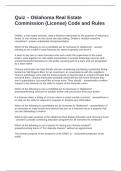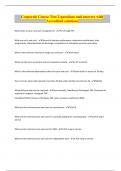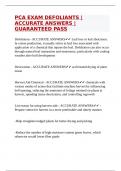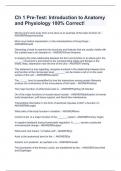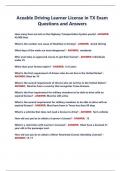4.1.4 PRODUCTION, COSTS AND REVENUE
PRODUCTIVITY
- way of measuring how efficiently a company or an economy is producing its output
- defined as the output per unit of input employed
LABOUR PRODUCTIVITY
- The amount of output produced per worker
- Labour productivity = output / total number of workers
- Allows workers to be compared against other workers
- Specialisation can improve labour productivity
SPECIALISATION
ADVANTAGES DISADVANTAGES
More competition gives firms an incentive to lower their costs, Workers end up doing repetitive tasks, could demotivate
keeping prices down workers potentially affecting quality and productivity
This can lead to better quality and a higher quantity of products Countries can become less self sufficient
for the same amount of effort - labour productivity
By producing a lot of one type of good through
Economies can achieve economies of scale specialisation, variety could in fact decrease
for consumers.
More efficient production, helps tackle scarcity because
resources are used more efficiently Structural unemployment since skills might not be transferable
Greater variety of goods There could be higher worker turnover for
firms, which means employees become
dissatisfied with their jobs and leave regularly
THE COSTS OF A FIRM
- A firm is any sort of business organisation
- An industry is all the firms providing similar goods or services
- A market contains all the firms supplying a particular good or service and the firms or people buying it
- Producing goods uses factors production making a cost
- Firms make profits = total revenue - total costs
COSTS + OPPORTUNITY COSTS
- Economic cost of production includes opportunity costs
- The opportunity costs of a factor of production is the money that you could have got by putting it to its next best use
FIXED AND VARIABLE COSTS
- Costs can be fixed or variable in the short run
- In the long run all costs are variable
FIXED COSTS VARIABLE COSTS
don’t vary with output in the short run - they have to paid whether or not variable costs do vary with output - they increase as output increase
anything is produced
the cost of plastic bags that a shop gives to customers is a variable cost -
For example, the rent on a shop is a fixed cost - it’s the same no matter the higher sales are, the higher the overall cost of the bags
what the sales are
TOTAL COSTS
- total costs is all the costs involved in producing a particular level of output
- total costs = total fixed costs + total variable costs
- TC = TFC + TVC
AVERAGE COSTS
- Average Cost is the cost per unit produced
13
, - Average Cost is calculated by dividing the total costs by the quantity produced
- Average Fixed Costs = total fixed costs / quantity produced
- Average Variable Costs = total variable costs / quantity produced
MARGINAL COST
- Marginal cost is the extra cost as a result of producing the final unit of output
- This is only affected by variable costs
- fixed costs have to be paid even if nothing is produced
LOWEST AVERAGE COST OCCURS WHEN (MC=AC)
- MC decreases initially as output increases, then begins to increase in the short
run because of the law of diminishing marginal returns
- This is why MC is U-shaped
- When MC is l0wer than AC, the average cost will be falling
- each extra unit produced will decrease the average cost
- When MC is higher than AC, the average cost will be rising
- each extra unit produced will increase the average cost
- So MC always crosses AC at its lowest point - also the productive efficient
point
- MC also meets AVC at the AVC minimum point
- MC is made up of variable costs so it increases and decreases like AC
- AFC (average fixed costs) falls as output increases because the total fixed cost is spread across the greater output
THE LAW OF DIMINISHING MARGINAL RETURNS
Explains what happens when a variable factor of production increases while other factors stay fixed and only applies in the short run
When you increase one factor of production by one
unit, but keep others fixed, the extra output you get
is the marginal product
E.g if you add one more unit of labour, the extra
unit of output is the marginal product of labour
THE LAW OF DIMINISHING MARGINAL RETURNS
States that adding extra units of a variable factor of production to a fixed factor of production will always lead to a fall in the marginal
product of the variable factor of production
DIMINISHING MARGINAL RETURNS + MARGINAL COST
● Marginal returns rise - marginal cost falls
● Marginal returns fall - marginal cost rises
● Marginal cost will rise as marginal returns fall
○ if you’re getting less additional output from each unit of input then the cost per unit
of that output will be greater
14
, DIMINISHING MARGINAL RETURNS + PRODUCTIVITY
1) The law of diminishing marginal returns says that as the level of a variable factor input is
increased, marginal product will eventually begin to diminish
2) As the level of that factor input continues to be increased, the average product will eventually
start to fall
3) The MP curve always meets the AP curve when the AP curve is at its maximum
4) If you keep adding more and more of the variable factor, you can reach a stage where adding
further input results in a fall in the total product
HOW TO IMPROVE PRODUCTIVITY
Increasing productivity will allow a firm to reduce its costs of production
1) Training
2) More efficient management
3) Technology
LONG RUN AVERAGE COSTS
● In the short run a firm has least one fixed factor of production
○ meaning that it operates on a short run average cost curve
● In the long run a firm can change all of its factors of production
meaning fixed costs can become variable
● The minimum possible average cost at each level of output is shown by
a long run average cost curve
● In the long run a firm can vary all factors of production and bring down
costs to the level of the LRAC
SHAPE OF THE LRAC
● Determined by internal economies of scale and diseconomies of scale
● Average cost falls as output increases when a firm is experiencing internal economies of scale
● Average cost rises as output increases when a firm is experiencing internal diseconomies of scale
RETURNS TO SCALE
● In the long run, costs are likely to be influenced by increasing or decreasing returns to scale
○ refers to the relationship between increases in the quantity of a firms input and the proportional change in output
Increasing returns to scale
● where an increase in the quantity of a firm’s inputs leads to a proportionally greater change in output.
○ e.g: a 5% increase in labour leads to a 10% increase in output
Constant returns to scale
● when an increase in the quantity of a firm’s inputs leads to a proportionally identical change in output
○ e.g: a 5% increase in labour leads to a 5% increase in output
Decreasing returns to scale
● where an increase in the quantity of a firm’s inputs leads to proportionally lower change in output
○ e.g: a 10% increase in labour leads to a 5% increase in output.
15
PRODUCTIVITY
- way of measuring how efficiently a company or an economy is producing its output
- defined as the output per unit of input employed
LABOUR PRODUCTIVITY
- The amount of output produced per worker
- Labour productivity = output / total number of workers
- Allows workers to be compared against other workers
- Specialisation can improve labour productivity
SPECIALISATION
ADVANTAGES DISADVANTAGES
More competition gives firms an incentive to lower their costs, Workers end up doing repetitive tasks, could demotivate
keeping prices down workers potentially affecting quality and productivity
This can lead to better quality and a higher quantity of products Countries can become less self sufficient
for the same amount of effort - labour productivity
By producing a lot of one type of good through
Economies can achieve economies of scale specialisation, variety could in fact decrease
for consumers.
More efficient production, helps tackle scarcity because
resources are used more efficiently Structural unemployment since skills might not be transferable
Greater variety of goods There could be higher worker turnover for
firms, which means employees become
dissatisfied with their jobs and leave regularly
THE COSTS OF A FIRM
- A firm is any sort of business organisation
- An industry is all the firms providing similar goods or services
- A market contains all the firms supplying a particular good or service and the firms or people buying it
- Producing goods uses factors production making a cost
- Firms make profits = total revenue - total costs
COSTS + OPPORTUNITY COSTS
- Economic cost of production includes opportunity costs
- The opportunity costs of a factor of production is the money that you could have got by putting it to its next best use
FIXED AND VARIABLE COSTS
- Costs can be fixed or variable in the short run
- In the long run all costs are variable
FIXED COSTS VARIABLE COSTS
don’t vary with output in the short run - they have to paid whether or not variable costs do vary with output - they increase as output increase
anything is produced
the cost of plastic bags that a shop gives to customers is a variable cost -
For example, the rent on a shop is a fixed cost - it’s the same no matter the higher sales are, the higher the overall cost of the bags
what the sales are
TOTAL COSTS
- total costs is all the costs involved in producing a particular level of output
- total costs = total fixed costs + total variable costs
- TC = TFC + TVC
AVERAGE COSTS
- Average Cost is the cost per unit produced
13
, - Average Cost is calculated by dividing the total costs by the quantity produced
- Average Fixed Costs = total fixed costs / quantity produced
- Average Variable Costs = total variable costs / quantity produced
MARGINAL COST
- Marginal cost is the extra cost as a result of producing the final unit of output
- This is only affected by variable costs
- fixed costs have to be paid even if nothing is produced
LOWEST AVERAGE COST OCCURS WHEN (MC=AC)
- MC decreases initially as output increases, then begins to increase in the short
run because of the law of diminishing marginal returns
- This is why MC is U-shaped
- When MC is l0wer than AC, the average cost will be falling
- each extra unit produced will decrease the average cost
- When MC is higher than AC, the average cost will be rising
- each extra unit produced will increase the average cost
- So MC always crosses AC at its lowest point - also the productive efficient
point
- MC also meets AVC at the AVC minimum point
- MC is made up of variable costs so it increases and decreases like AC
- AFC (average fixed costs) falls as output increases because the total fixed cost is spread across the greater output
THE LAW OF DIMINISHING MARGINAL RETURNS
Explains what happens when a variable factor of production increases while other factors stay fixed and only applies in the short run
When you increase one factor of production by one
unit, but keep others fixed, the extra output you get
is the marginal product
E.g if you add one more unit of labour, the extra
unit of output is the marginal product of labour
THE LAW OF DIMINISHING MARGINAL RETURNS
States that adding extra units of a variable factor of production to a fixed factor of production will always lead to a fall in the marginal
product of the variable factor of production
DIMINISHING MARGINAL RETURNS + MARGINAL COST
● Marginal returns rise - marginal cost falls
● Marginal returns fall - marginal cost rises
● Marginal cost will rise as marginal returns fall
○ if you’re getting less additional output from each unit of input then the cost per unit
of that output will be greater
14
, DIMINISHING MARGINAL RETURNS + PRODUCTIVITY
1) The law of diminishing marginal returns says that as the level of a variable factor input is
increased, marginal product will eventually begin to diminish
2) As the level of that factor input continues to be increased, the average product will eventually
start to fall
3) The MP curve always meets the AP curve when the AP curve is at its maximum
4) If you keep adding more and more of the variable factor, you can reach a stage where adding
further input results in a fall in the total product
HOW TO IMPROVE PRODUCTIVITY
Increasing productivity will allow a firm to reduce its costs of production
1) Training
2) More efficient management
3) Technology
LONG RUN AVERAGE COSTS
● In the short run a firm has least one fixed factor of production
○ meaning that it operates on a short run average cost curve
● In the long run a firm can change all of its factors of production
meaning fixed costs can become variable
● The minimum possible average cost at each level of output is shown by
a long run average cost curve
● In the long run a firm can vary all factors of production and bring down
costs to the level of the LRAC
SHAPE OF THE LRAC
● Determined by internal economies of scale and diseconomies of scale
● Average cost falls as output increases when a firm is experiencing internal economies of scale
● Average cost rises as output increases when a firm is experiencing internal diseconomies of scale
RETURNS TO SCALE
● In the long run, costs are likely to be influenced by increasing or decreasing returns to scale
○ refers to the relationship between increases in the quantity of a firms input and the proportional change in output
Increasing returns to scale
● where an increase in the quantity of a firm’s inputs leads to a proportionally greater change in output.
○ e.g: a 5% increase in labour leads to a 10% increase in output
Constant returns to scale
● when an increase in the quantity of a firm’s inputs leads to a proportionally identical change in output
○ e.g: a 5% increase in labour leads to a 5% increase in output
Decreasing returns to scale
● where an increase in the quantity of a firm’s inputs leads to proportionally lower change in output
○ e.g: a 10% increase in labour leads to a 5% increase in output.
15



